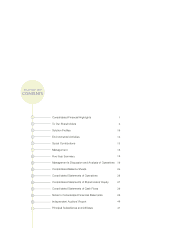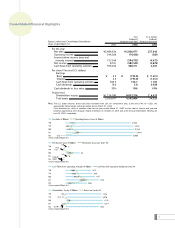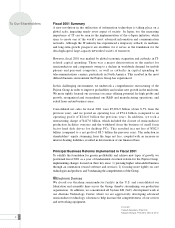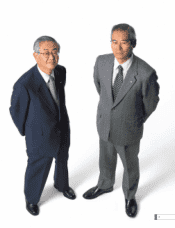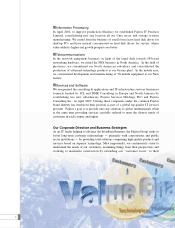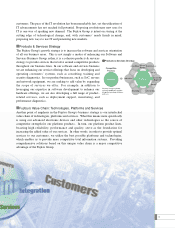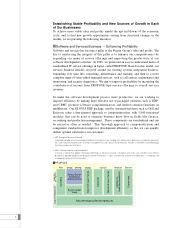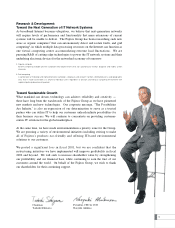Fujitsu 2002 Annual Report Download - page 8
Download and view the complete annual report
Please find page 8 of the 2002 Fujitsu annual report below. You can navigate through the pages in the report by either clicking on the pages listed below, or by using the keyword search tool below to find specific information within the annual report.
Establishing Stable Profitability and New Sources of Growth in Each
of Our Businesses
To achieve more stable sales and profits amidst the ups and downs of the economic
cycle, and to find new growth opportunities arising from structural changes in the
market, we are pursuing the following measures.
Software and Services Business
-
Enhancing Profitability
Software and services has become a pillar of the Fujitsu Group’s sales and profits. The
key to reinforcing the integrity of this pillar is to enhance our competitiveness by
expanding our menu of service offerings and improving the productivity of our
software development activities. In 1992, we pioneered an easy-to-understand menu of
standardized IT service offerings in Japan, called PROPOSE. Based on this model, our
services business initially revolved around our existing systems integration business,
expanding over time into consulting, maintenance and training, and then to a more
complete range of value-added managed services, such as call centers, maintenance and
monitoring, and security diagnostics. We aim to improve profitability by increasing the
contribution of income from PROPOSE-type service offerings to overall services
revenues.
To make the software development process more productive, we are working to
improve efficiency by making more effective use of packaged solutions, such as ERP1
and CRM2; promote software componentization; and embed common functions in
middleware. Our GLOVIA ERP package, used by international firms such as Dell and
Ericsson, takes a fine-grained approach to componentization, with 1,800 functional
modules that can be used to organize business know-how in fields like finance,
accounting and production management. These components are standardized and can
be reused as often as needed. This thorough approach to componentization and
component standardization improves development efficiency so that we can quickly
deliver optimal solutions to our customers.
1. ERP: Enterprise Resource Planning
Integrated management of accumulated company information in areas ranging from administrative processes (accounting, personnel,
etc.) and manufacturing processes (inventory management) to sales processes (distribution). Provides a framework and methodology
for increasing business efficiency.
2. CRM: Customer Relationship Management
A business method that applies information technology to enhance customer satisfaction and make sales activities more efficient.
Based on a detailed database of individual customer interactions
-
sales, maintenance, inquiries and follow-ups
-
it integrates the
management and use of this information.
PROPOSE
6


